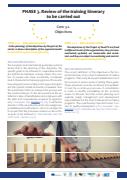PHASE 3. Review of the training itinerary to be carried out Core 3.1. Objectives ITEM 3.1.1. Educational center In the planning of the objectives by the part of the center, is done a description of the expected results Completel/Enough/Something/Nothing RECOMMENDATIONS: The European and international guarantee systems advise that in the planning of the objectives, the specific goals to be achieved in measurable results are defined and detailed. Among others, the num- ber of people who have successfully completed Dual Professional Formative programs or those who have dropped out according to the type of program and the specific criteria should be considered. Also those indicators that can measure the process and the results achieved. To the same extent as the sa- tisfaction rates of beneficiaries and employers with the skills and competencies acquired by apprenti- ces [1. European. See: EQAVET P4, P6]. It will be the direction of the educational center who assigns res- ponsibilities and authorities to whom it corresponds to ensure that the processes carried out allow the- se goals to be achieved [2. International. See: ISO 21001:2018 – Section 5.3.c]ITEM 3.1.2. Educational center The objectives of the Project of Dual PF are fixed in different levels of the organization, they are com- municated, updated, are measurable and consis- tent and they are object to monitoring and control. Completel/Enough/Something/Nothing RECOMMENDATIONS: The correct definition of the objectives is the fun- damental basis of any Dual Professional Formative programs. That is why all relevant stakeholders must be involved at various levels in setting these goals. These objectives must be monitored and updated. It must be a continuous process of consultations in order to identify immediately all the concrete needs. To this end, from the outset, planning must explicitly assign management and development responsibilities for the Dual Professional Formative programs. This is particularly important when it co- mes to quality development. [one. European. See: EQAVET P3] [2. International. See: ISO 21001:2018 – Section 6.2.1]
